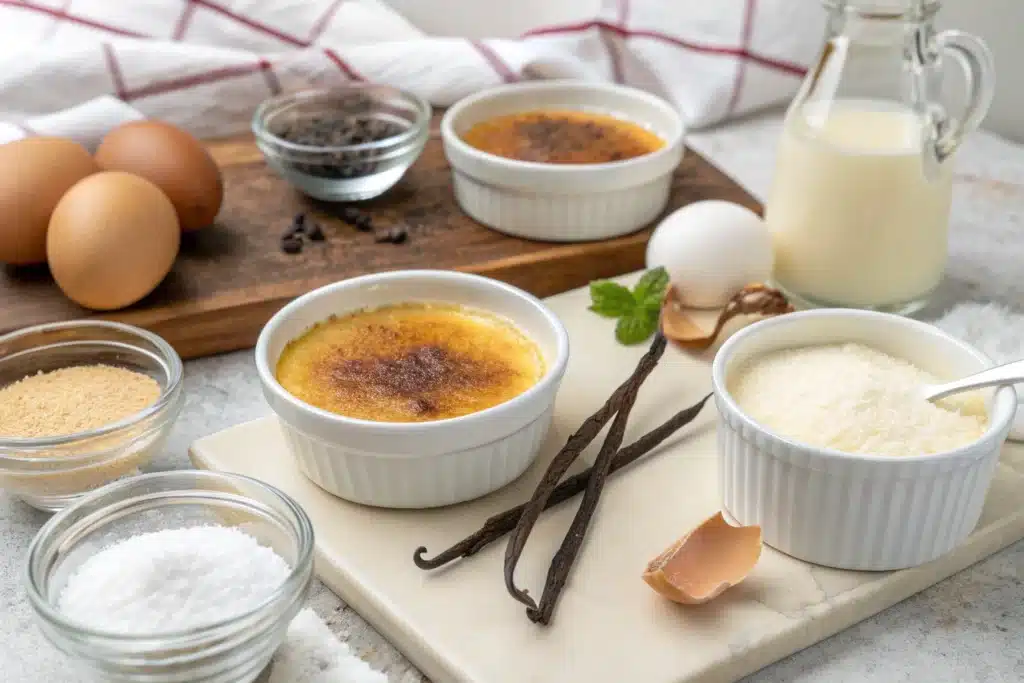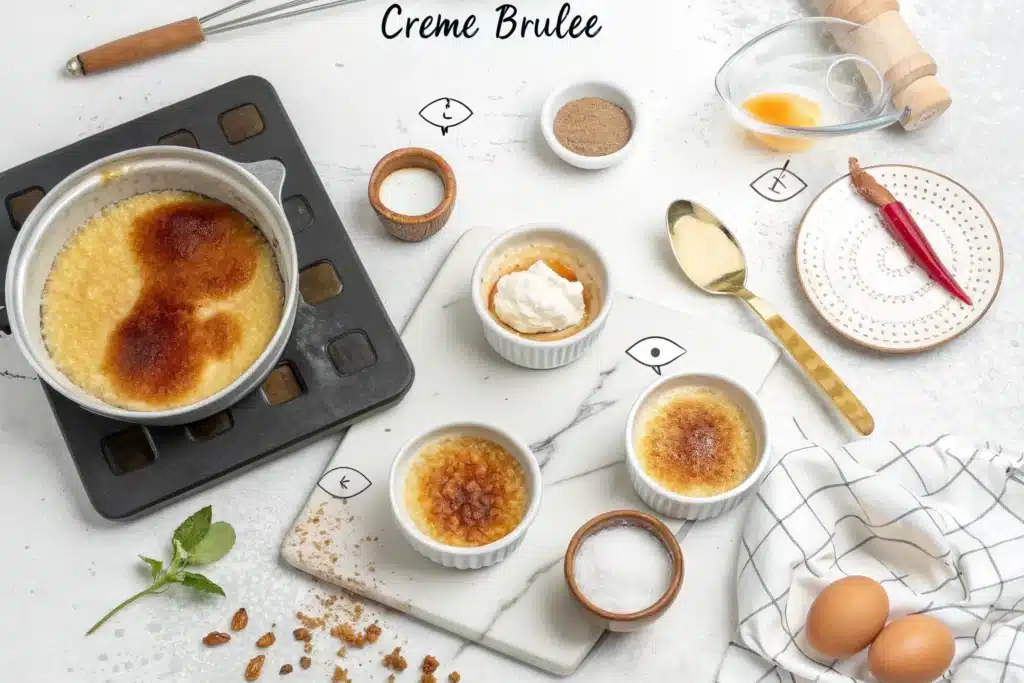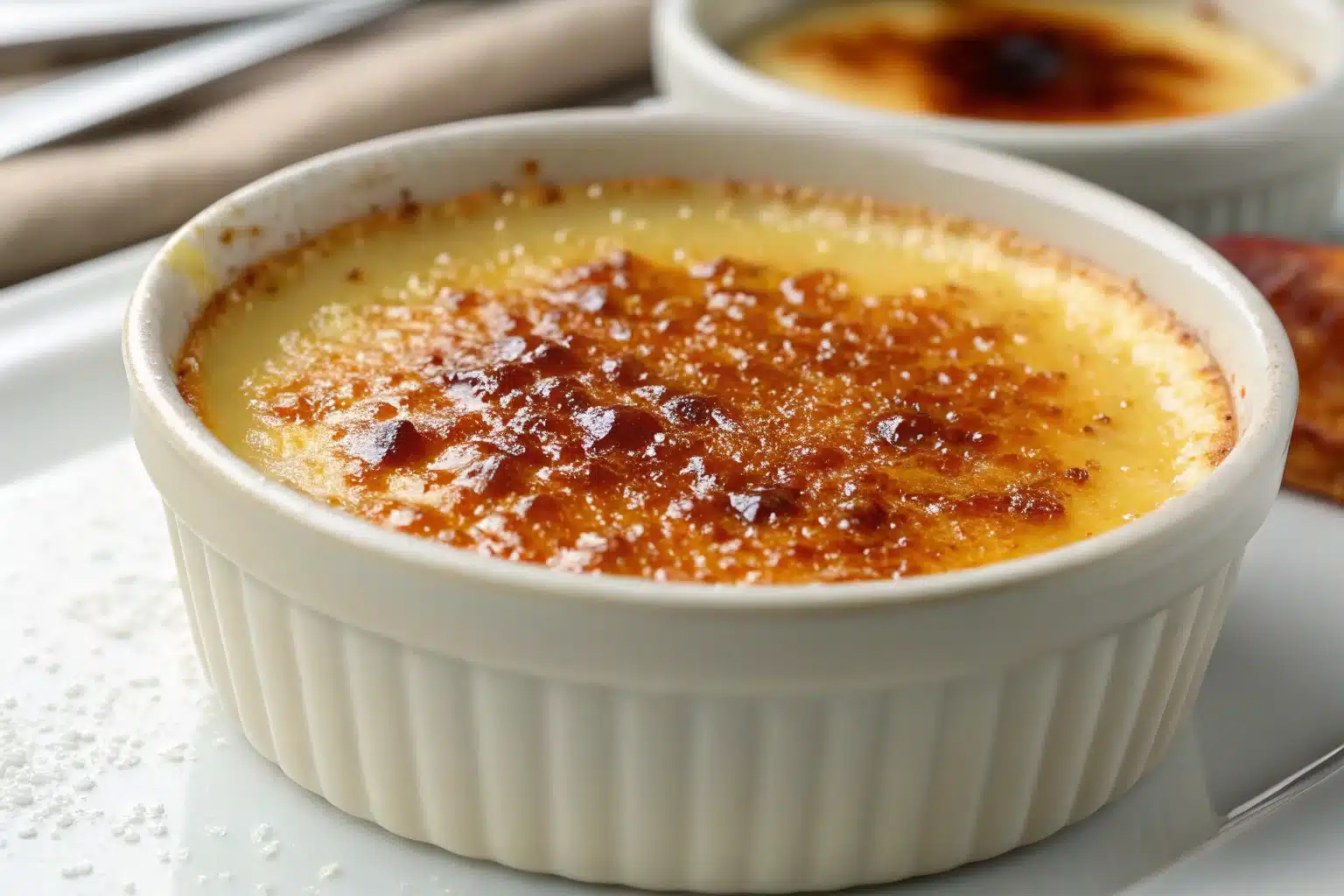Introduction
Crème brûlée—just the name itself sounds elegant, doesn’t it? This classic French dessert is a staple of fine dining and a favorite among home bakers who want to impress guests with something creamy, rich, and delightfully crunchy on top. But have you ever wondered, What is crème brûlée mostly made of?
At first glance, it might seem like a complicated dish reserved for top-tier chefs. However, crème brûlée is made with just a handful of simple ingredients—primarily heavy cream, egg yolks, sugar, and vanilla. The magic happens when these ingredients come together through precise cooking techniques, resulting in that silky-smooth custard topped with a beautifully caramelized sugar crust.
In this article, we’ll break down everything you need to know about crème brûlée, from its history to its science and, most importantly, the ingredients that make it so irresistible. We’ll also explore modern variations, share common mistakes to avoid, and even discuss healthier alternatives for those looking to enjoy this treat with a twist.
So, if you’re ready to unlock the secrets of this classic dessert, let’s dive into the heart of the question: What is crème brûlée mostly made of?
Introduction to Crème Brûlée
What Is Crème Brûlée?
Crème brûlée is a luxurious French dessert consisting of a rich, velvety custard base topped with a layer of hard, caramelized sugar. The name literally translates to “burnt cream,” referring to the crispy, golden-brown crust created by torching sugar just before serving.
What makes crème brûlée special is its contrasting textures: the smooth, creamy custard pairs beautifully with the brittle caramel topping, offering a satisfying crack when tapped with a spoon. This interplay of flavors and mouthfeel is why it remains a timeless favorite in French cuisine and beyond.
A Brief History of Crème Brûlée
Though crème brûlée is widely regarded as a French classic, its origins are actually a topic of debate among food historians. Some claim it dates back to 17th-century France, while others argue that similar desserts existed in Spain (crema catalana) and England (burnt cream) around the same time.
- French Origins: The first recorded mention of crème brûlée appeared in a 1691 French cookbook by François Massialot, a chef who served royalty. His version closely resembles what we enjoy today.
- Spanish Influence: Spain’s crema catalana—a dessert with a nearly identical composition—dates back even earlier and is made with milk instead of heavy cream and thickened with cornstarch.
- English Counterpart: In Cambridge, England, a similar dish called Trinity Cream became famous in the 19th century and was served at Trinity College.
Regardless of where it first appeared, crème brûlée has firmly established itself as a symbol of sophistication in modern cuisine, gracing restaurant menus worldwide.
Why Is Crème Brûlée So Popular Worldwide?
What makes this dessert so beloved? A few key reasons:
- It’s simple yet decadent – With just a few ingredients, crème brûlée delivers a luxurious taste and texture.
- The contrast is irresistible – The crunch of caramelized sugar against the silky custard creates an unmatched sensory experience.
- It feels fancy but is surprisingly easy to make – Despite its reputation, it doesn’t require complex techniques.
- It’s endlessly customizable – From chocolate-infused versions to fruity variations, chefs and home cooks love experimenting with flavors.
No wonder crème brûlée remains a staple in high-end restaurants and home kitchens alike.
If you’re looking for a creative twist, try this crab brûlée recipe, which showcases its versatility in savory applications
What Is Crème Brûlée Mostly Made Of? Key Ingredients

Crème brûlée may seem like a fancy, complex dessert, but at its core, it’s made with just a few simple ingredients. If you’ve ever wondered, What is crème brûlée mostly made of?—the answer is straightforward: heavy cream, egg yolks, sugar, and vanilla. These four elements come together to create a rich, silky custard topped with a crisp caramelized sugar crust.
But what makes each ingredient essential? Let’s break it down.
The Core Ingredients of Crème Brûlée
At first glance, crème brûlée appears to be nothing more than eggs, sugar, and cream. However, each of these ingredients plays a crucial role in shaping the dessert’s texture, flavor, and structure.
- Heavy Cream – The base of crème brûlée, responsible for its luxurious, velvety texture.
- Egg Yolks – The thickening agent that gives the custard its signature creaminess.
- Sugar – Used both in the custard for sweetness and on top for caramelization.
- Vanilla – The primary flavor enhancer, adding depth and warmth.
Each ingredient works in harmony to create the dessert we all know and love. Now, let’s explore their individual roles.
The Role of Each Ingredient in Crème Brûlée
Egg Yolks: The Foundation of Creaminess
Egg yolks are the secret weapon in crème brûlée, giving the custard its smooth, creamy texture. When combined with sugar and gently heated with cream, the yolks thicken the mixture without making it too firm.
- The proteins in egg yolks coagulate when heated, forming a custard-like consistency.
- The more yolks used, the richer and denser the texture.
- Whole eggs can be used, but yolks alone create a silkier finish.
Without egg yolks, crème brûlée would lack its signature creaminess and structure.
Heavy Cream: Creating a Luxurious Texture
The “crème” in crème brûlée comes from heavy cream, which provides the dessert’s rich, buttery mouthfeel. Compared to milk, heavy cream contains:
- A higher fat content, which makes the custard thicker and more indulgent.
- A silky texture that melts in your mouth.
- Stability when baked at low temperatures, ensuring a smooth finish without curdling.
Some recipes substitute part of the cream with milk to lighten the texture, but true crème brûlée relies on heavy cream for maximum richness.
Sugar: Balancing Sweetness & Caramelization
Sugar in crème brûlée serves two purposes:
- Sweetening the custard – A small amount of sugar balances the richness of the eggs and cream without making the dessert overly sweet.
- Creating the caramelized crust – When sugar is torched or broiled, it melts and hardens into a delicate, glassy shell.
The best type of sugar for caramelization is superfine granulated sugar, as it melts evenly and creates a thin, crisp crust.
Vanilla & Other Flavor Enhancements
Vanilla is the classic flavoring for crème brûlée, enhancing its sweet, aromatic depth. However, chefs often experiment with variations like:
- Vanilla beans – For a stronger, more natural vanilla flavor with visible specks.
- Citrus zest (orange, lemon, lime) – Adds a refreshing twist.
- Coffee or espresso – Creates a bold, slightly bitter contrast.
- Chocolate, matcha, or lavender – Offers unique flavor profiles while maintaining the custard’s creaminess.
The Science Behind Crème Brûlée
Cooking crème brûlée isn’t just about mixing ingredients and baking—it’s about understanding how heat, proteins, and sugar interact. Achieving that perfect balance of creamy custard and crisp sugar topping requires precision, patience, and a little bit of chemistry.
What Happens When You Cook the Custard?
Crème brûlée starts as a liquid mixture of eggs, sugar, and heavy cream. But once baked, it transforms into a silky-smooth custard. How does this happen?
- Protein coagulation: When egg yolks are heated, their proteins unfold and bond together, thickening the mixture.
- Slow, gentle cooking: A bain-marie (water bath) prevents the eggs from scrambling and ensures even heat distribution.
- The right temperature: Baking at low heat (300–325°F) helps the custard set without curdling.
Without this precise process, the custard could turn grainy, rubbery, or soupy.
The Role of Caramelization in the Sugar Topping
The crunchy caramelized sugar topping is what makes crème brûlée iconic. This magic happens through a process called caramelization, where sugar breaks down and transforms into a golden-brown crust.
- At around 320°F (160°C), sugar begins to melt.
- At 340–350°F (170–175°C), it caramelizes, creating complex flavors ranging from nutty to slightly bitter.
- Overheating (above 375°F/190°C) can lead to burnt, bitter sugar.
Most chefs use a culinary torch for precise caramelization, but a broiler can also work—just be careful not to overdo it.
How Baking Time and Temperature Affect Texture
Cooking crème brûlée is all about timing and temperature control. If it’s overbaked, the custard becomes rubbery. If underbaked, it remains liquid.
Here’s what happens at different baking temperatures:
| Baking Temperature | Effect on Custard |
|---|---|
| 275°F (135°C) | Slow, gentle setting for extra creamy texture. |
| 300°F (150°C) | Ideal balance between firmness and creaminess. |
| 325°F (160°C) | Faster setting but slightly firmer texture. |
| 350°F (175°C) | Risk of overcooking, leading to scrambled eggs. |
Why a Water Bath (Bain-Marie) Is Essential
A bain-marie is a water bath that surrounds the custard with gentle, even heat, preventing it from cooking too fast.
- Prevents curdling – The water keeps temperatures stable, avoiding scrambled eggs.
- Ensures even cooking – The custard bakes smoothly without cracking.
- Controls moisture loss – Helps retain the dessert’s creamy consistency.
Without a bain-marie, the edges of the custard may overcook while the center stays runny.
Step-by-Step Guide to Making Crème Brûlée

Now that we’ve explored what crème brûlée is mostly made of and the science behind its creamy texture, it’s time to put that knowledge into practice. Making crème brûlée might seem intimidating, but with the right technique, you can achieve restaurant-quality results in your own kitchen.
Follow this step-by-step guide to create the perfect crème brûlée, complete with a smooth custard and a crisp caramelized sugar topping.
Essential Kitchen Tools for Making Crème Brûlée
Before diving into the recipe, make sure you have the right tools. These will ensure even cooking, proper texture, and the signature caramelized crust.
- Ramekins – Small, oven-safe dishes that help cook the custard evenly.
- Whisk – For mixing the egg yolks and sugar without overbeating.
- Mixing bowls – To combine ingredients smoothly.
- Fine-mesh strainer – Helps remove lumps for an ultra-smooth custard.
- Baking dish – Needed to create a bain-marie (water bath).
- Torch or broiler – Essential for caramelizing the sugar topping.
Step-by-Step Instructions for a Perfect Crème Brûlée
Preparing the Custard
- Preheat your oven to 325°F (160°C). Place ramekins in a deep baking dish.
- Whisk egg yolks and sugar. In a mixing bowl, whisk together 6 egg yolks and ½ cup sugar until pale and slightly thick.
- Heat the cream. In a saucepan, heat 2 cups of heavy cream until it just starts to steam (do not boil).
- Temper the eggs. Slowly pour the warm cream into the egg mixture while whisking constantly. This prevents the eggs from scrambling.
- Add vanilla. Stir in 2 teaspoons of vanilla extract or scraped vanilla bean seeds for enhanced flavor.
Baking the Custard Properly
- Strain the mixture. Pour the custard through a fine-mesh strainer to remove any lumps.
- Fill the ramekins. Divide the custard evenly among the ramekins.
- Create a water bath. Pour hot water into the baking dish until it reaches halfway up the sides of the ramekins. This prevents the custard from overheating.
- Bake gently. Bake for 30–40 minutes, or until the custard is set but still slightly jiggly in the center.
- Cool and refrigerate. Let the ramekins cool to room temperature, then refrigerate for at least 2 hours (preferably overnight) to allow the custard to firm up.
Chilling and Caramelizing the Sugar Topping
- Sprinkle sugar evenly. Add about 1 tablespoon of sugar on top of each custard.
- Caramelize the sugar. Use a culinary torch to melt the sugar, moving it in small circles until it turns golden and crispy. Alternatively, place the ramekins under a broiler for 1–2 minutes.
- Let the sugar harden. Allow the caramelized top to cool for a minute before serving.
That’s it! Your homemade crème brûlée is ready to enjoy. Serve immediately for the best contrast between the warm, crunchy sugar crust and the cold, creamy custard.
Variations and Modern Twists on Crème Brûlée
While classic crème brûlée is always a hit, creative chefs and home bakers have developed exciting variations that take this dessert to the next level. Whether you want to experiment with new flavors, dairy-free alternatives, or modern presentations, there are endless ways to make this dish unique.
Popular Flavor Variations of Crème Brûlée
Classic vanilla crème brûlée is delicious, but why not try something different? Here are some creative twists:
Chocolate, Coffee, and Matcha Crème Brûlée
- Chocolate Crème Brûlée – Melted dark chocolate is mixed into the custard, giving it a rich, decadent taste.
- Coffee Crème Brûlée – Espresso or strong brewed coffee adds a deep, bold flavor that pairs well with the caramelized sugar topping.
- Matcha Crème Brûlée – Green tea powder adds an earthy, slightly bitter contrast to the sweet custard.
Fruit-Infused Crème Brûlée (Citrus, Berry, and Exotic Fruits)
- Orange or Lemon Zest – Bright citrus zest enhances the custard’s richness.
- Berry Purée Swirl – A strawberry, raspberry, or blueberry swirl adds a refreshing, slightly tart note.
- Tropical Twist – Passionfruit, mango, or coconut-infused crème brûlée brings a vacation-worthy flavor profile.
Creative Presentation Ideas for Crème Brûlée
Why stick to the traditional ramekin when you can get creative? Here are some fun ways to serve crème brûlée:
- Inside Fruit Bowls – Serve in hollowed-out oranges, grapefruits, or coconuts for a fresh presentation.
- Mini Mason Jars – Create portable, individual portions perfect for parties.
- In Tart Shells – Pour the custard into pre-baked pastry shells for a crisp, edible base.
Dairy-Free and Vegan Crème Brûlée Alternatives
Want to enjoy crème brûlée without dairy or eggs? Here’s how:
- Coconut Milk or Almond Milk – Replaces heavy cream while keeping a smooth texture.
- Cashew Cream – Provides a rich, nutty flavor similar to heavy cream.
- Agar-Agar or Cornstarch – Acts as a thickening agent instead of egg yolks.
These alternatives allow everyone to enjoy this beloved dessert without compromising on taste or texture.
I invite you to discover very easy, delicious and tasty recipes her
FAQs About Crème Brûlée
1. Can You Make This Dessert Without a Torch?
Yes! The sugar topping can be caramelized under a broiler if you don’t have a kitchen torch.
2. What’s the Difference Between This Dessert and Flan?
While both are custard-based desserts, flan is topped with a soft caramel sauce, whereas this dessert features a hard caramelized sugar crust.
3. Is This Dessert Gluten-Free?
Yes, traditional recipes are naturally gluten-free as they do not contain flour or other gluten-based ingredients.
Conclusion: The Timeless Appeal of Crème Brûlée
This dessert masterfully balances rich creaminess with a satisfying crunch, making it an enduring favorite. Whether you enjoy the classic version or experiment with creative variations, its versatility is part of its charm. Why not try making it at home and explore its delightful possibilities? For a savory spin, don’t forget to check out the crab brûlée recipe, or consider pairing it with colorful side dishes like those found in purple sweet potato recipes.
Enjoy crafting this timeless dessert!

